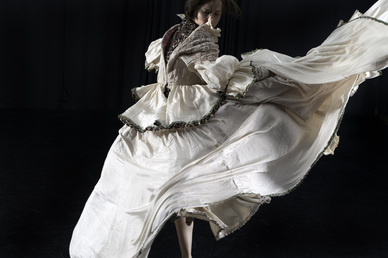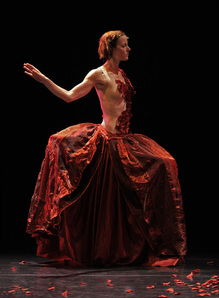 Audrée Juteau est Orlando, photo de Jessica Petunia Audrée Juteau est Orlando, photo de Jessica Petunia Je vais vous raconter une histoire. Au lieu de mots, je vais utiliser le mouvement. Vous le savez déjà; c’est une mauvaise idée. La danse, c’est un médium horrible pour raconter des histoires. Avez-vous déjà vu un épisode de So You Think You Can Dance où les chorégraphes expliquent la petite histoire derrière leur pièce de deux minutes? Ça prend une couple de Gravols juste pour passer à travers toutes les quétaineries qui sortent de leurs bouches. C’est sans parler de la danse elle-même… Pour son nouveau spectacle de danse-théâtre, la chorégraphe Deborah Dunn s’est inspirée d’Orlando de Virginia Woolf. C’est correct. Le problème, c’est qu’elle est demeurée beaucoup trop près du texte. En fait, on pourrait presque plus parler d’adaptation que d’inspiration. Si une scène de bal est pour être une platitude chorégraphique, pourquoi en avoir une? Dans sa pièce de groupe précédente, Nocturnes, Dunn s’était inspirée du mélodrame. Elle avait étudié la gestuelle mélodramatique et l’avait amplifiée jusqu’à ce qu’elle devienne danse. Ici, rien n’est aussi poussé, rien ne se transforme. Tout demeure dans la performance costumée mais désincarnée, de sorte qu’on a souvent l’impression d’assister à un spectacle collégial plutôt que professionnel. Ce n’est pas assez dramatique ou assez drôle (même si les six interprètes nous lancent des clins d’œil à chaque minute); c’est trop éclairé et certainement trop littéral. C’est aussi, disons-le, chorégraphiquement pauvre. À la fin du spectacle, Dunn délaisse le théâtre et offre un losange aux angles de duos simultanés. Ce n’est pas que ça devient soudainement chorégraphiquement génial, mais l’amélioration est flagrante maintenant que le mouvement ne tombe pas dans une symbolique, dans un théâtre physique facile. Je n’ai pas besoin de mouvements qui veulent dire quelque chose; j’ai besoin de mouvements qui disent quelque chose. C’est la beauté de la danse contemporaine : le mouvement parle de lui-même; on n’a pas besoin de lui imposer une signification littéraire. Dunn devrait avoir plus confiance en ses qualités de chorégraphe. Voilà ce que je suggère pour son prochain show : pas de texte, pas d’éclairage théâtral, pas de musique, même pas de costumes. Après tout, on parle de danse contemporaine. Ce serait comme un saut dans le noir, un peu épeurant. La peur est souvent un bon guide artistique. Orlando 14-16 mars à 20h & 17 mars à 16h Agora de la danse www.agoradanse.com 514.525.1500 Billets : 26$ / Étudiants & moins de 30 ans : 18$
0 Comments
 Four Quartets, photo by Chris Randle I’ve never been able to read with my ears. This tragedy has made it so that, despite my best and nerdiest intentions, I have failed to get into This American Life. So part of me feels that I’ve somewhat missed out on the experience that is Deborah Dunn’s Four Quartets. Not that the choreographer’s dance has anything to do with the popular radio show. As its title suggests, it is T.S. Eliot’s poetry that is centre stage here. And, of course, Dunn herself. She is the sole dancer of all four pieces that compose the show. Also not to be neglected is the voice of Sir Alec Guinness. A recording of his reading of Eliot is the inspiration for the project and is used for the first two pieces. At first, there appears to be a disjunction between the echoing voice of Guinness, mysterious, and the high-key lighting that reveals everything. However, as we get used to the juxtaposition, it comes to create a legitimate third entity: Dunn’s “Burnt Norton.” The first thing that grabs my attention in Dunn’s choreography is her hands. Who knew that contemporary dancers have hands, and that they can bend at the wrist? Only in butoh are the hands usually such a focal point, so thoroughly used. Her body consciousness goes all the way to the tip of her fingers, her hands as straight as an outstreched arm and as flat as a blade. With her angular arm shapes, Dunn looks like a series of Egyptian hieroglyphics. Her movement language is sometimes so interpretive that it also becomes a code, like these hand-birds that kiss in a charmingly playful manner. Sometimes her hands show the only visible skin on her body, like when one curved hand is covering her face and the other her crotch. Against the dark fabric of her tailor suit, it is the symmetrical positioning of her hands that hits us. This attention to details is Dunn’s strength. Not that everything is a matter of hands. As Dunn appears in one spot and then another and yet another, it becomes obvious that, while our attention is on her arms, her legs are traveling across the space to cover as much ground as she singlehandedly can. For short periods of time, the lighting changes. It becomes low-key, spotted, focused on Dunn’s immobile body. It highlights her pauses, moments of stillness that feel like spaces for breath before diving back underwater. Between sections, Dunn moves to the back of the stage where a lamp, table, and chair wait for her. These are brief moments of rest, for both dancer and audience. They are extremely similar to the device that José Navas used in his own solo show. It is also then that the title of each poem appears, rather unnecessarily so, especially since the video projector produces a significant humming noise and goes otherwise unused. Another disparity emerges in the second piece, “East Coker.” This time, the deep and reassuring voice of Guinness contrasts with Diane Labrosse’s electronic music, yet the two work together perfectly. Kudos to Labrosse for not taking the most obvious route and pulling it off admirably. The third section, “The Dry Salvages,” appears as the most theatrical and the dance as the most interpretive, probably because Dunn herself is performing the poem live. The words begin to appear as prompts that directly spur the movement. My own anti-narrative inclinations made it so that it was my least favourite section, as I wondered if it were necessary for the words to be spoken out loud rather than just use them to inspire the choreography. Of course, there is no way to know for sure without seeing the different results. In the final section, “Little Gidding,” a rarity in dance shows: pink lighting. Less rare: a skin-coloured leotard (no joke), the kind of costume that, thank God, is never seen outside of a dance show. Fortunately, most of it soon gets covered up by a large red skirt with a silky texture. The third section still fresh in our mind, the movement continues to appear a tad too literal. However, Dunn compensates by sprinkling a few humorous touches along the way, like when she lifts up her skirt and walks in a deeply affected manner that looks more like a galloping horse than a display of femininity. After the year started with quite a few intense ensemble works (BJM Danse, The New Bourjoiesie, La pornographie des âmes, Junkyard/Paradis), the simplicity of Dunn’s Four Quartets comes like a breath of fresh air. The simplicity is not in the movement, which is quasi-constant and varied, but in the presentation. At her best, Dunn reminds us of Peggy Baker. As far as comparisons go, one could do much worse. Four Quartets February 3-5 at 7:30pm, February 6 at 4pm Tangente (presented by Agora de la danse) www.agoradanse.com / www.tangente.qc.ca 514.525.1500 Tickets: 20$/14$ for students and people under 30 |
Sylvain Verstricht
has an MA in Film Studies and works in contemporary dance. His fiction has appeared in Headlight Anthology, Cactus Heart, and Birkensnake. s.verstricht [at] gmail [dot] com Categories
All
|
 RSS Feed
RSS Feed